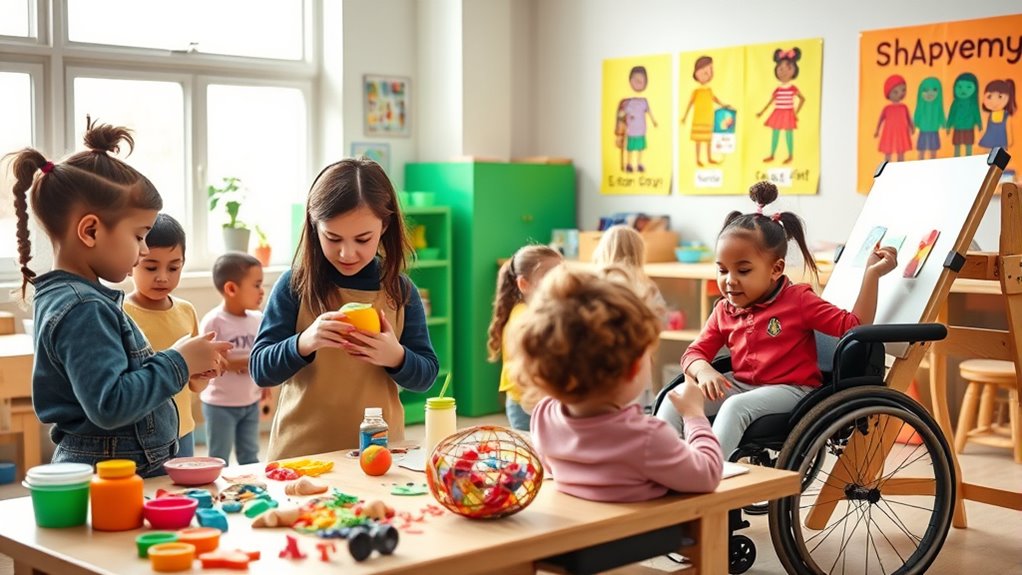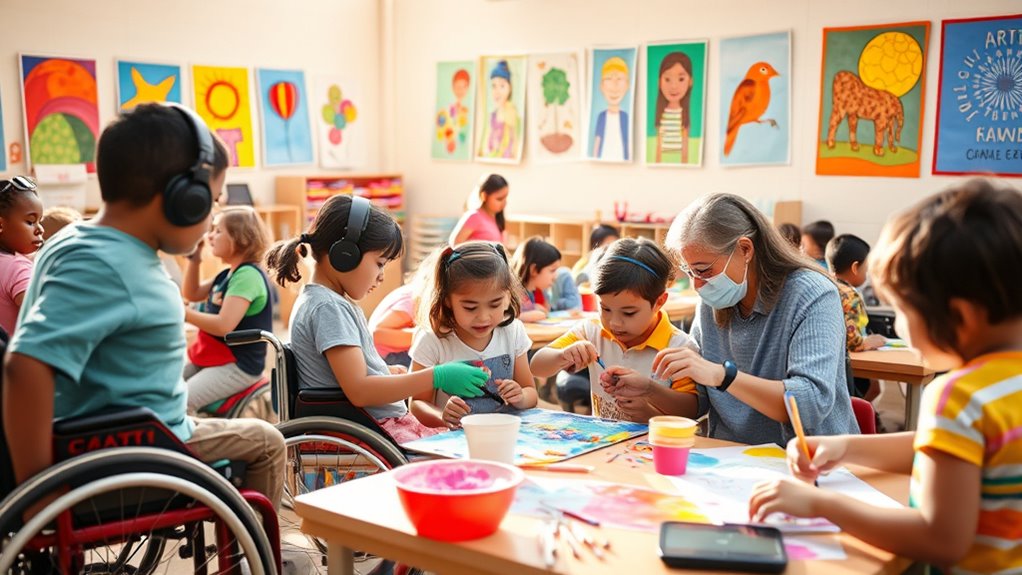To create inclusive art education for diverse learners, adapt tools and environments to meet individual needs using textured paints, large brushes, and technology like touchscreen devices. Foster collaboration through group projects that value different skills and strengths, encouraging peer interaction and open communication. Maintain a positive, supportive atmosphere by celebrating each student’s contributions and using patience and empathy. Exploring these strategies further will help you develop a more inclusive, engaging classroom that supports all learners effectively.
Key Takeaways
- Implement adaptive techniques like textured paints, adjustable workstations, and assistive technologies to meet diverse learner needs.
- Design collaborative projects that leverage students’ strengths and promote peer interaction and community building.
- Tailor art activities to individual interests and abilities, allowing all students to contribute meaningfully and actively.
- Foster a positive, supportive environment through patience, empathy, and celebrating diverse contributions to enhance inclusion.
- Utilize resources, ongoing professional development, and creative practices to stay informed and improve inclusive art teaching strategies.

Have you ever wondered how art education can be made accessible to everyone, regardless of their background or abilities? The key lies in adopting adaptive techniques that cater to diverse needs and fostering collaborative projects that encourage inclusion. When you design lessons with flexibility in mind, you create a space where all students can express themselves and engage meaningfully. Adaptive techniques might involve modifying tools, materials, or the environment to suit individual needs. For example, using textured paints, large brushes, or adjustable workstations ensures students with physical limitations can participate fully. Incorporating technology, such as touchscreen devices or voice-activated tools, can also make art creation more accessible. These adaptations demonstrate that with thoughtful planning, barriers can be minimized, allowing students to explore their creativity without frustration or exclusion. Furthermore, maintaining a positive environment enhances students’ confidence and willingness to participate. Collaborative projects play a crucial role in promoting inclusion, as they foster peer interaction and build a sense of community. When students work together on art tasks, they learn to appreciate different perspectives and develop empathy. You can design projects that require diverse skills, encouraging students to contribute in ways that suit their abilities. For instance, some students might focus on creating visual elements, while others handle storytelling or digital aspects. This approach not only validates each learner’s strengths but also teaches the importance of teamwork and shared achievement. It’s important to create an environment where everyone feels their input is valued, which can be achieved by establishing clear roles and encouraging open communication. Involving students in the planning process helps tailor projects to their interests and needs, making learning more engaging and meaningful. This participatory approach increases motivation and ownership, fostering a sense of belonging. Additionally, using adaptive techniques during collaborative projects ensures that each student, regardless of abilities, can actively contribute. For example, if a student has difficulty with fine motor skills, they might contribute through digital editing or verbal input rather than traditional drawing. According to the Law of Attraction, focusing on positive intent and aligning actions can attract supportive opportunities and environments. By combining adaptive techniques with collaborative efforts, you create an inclusive environment that recognizes and celebrates each learner’s potential. Embracing personality traits such as patience, flexibility, and empathy can significantly enhance the effectiveness of inclusive teaching strategies. Ultimately, making art education inclusive requires intentionality and creativity. When you embrace adaptive techniques and promote collaborative projects, you break down barriers and cultivate a space where every student can thrive. This approach not only enhances individual growth but also enriches the entire learning community. You’ll find that through these strategies, art becomes a tool for connection, expression, and empowerment for all learners, regardless of their background or abilities. Incorporating awareness of resources and tools available for inclusive education can further support teachers in implementing these strategies effectively. Recognizing the importance of creative practice in inclusive settings can also inspire innovative approaches to teaching. Additionally, ongoing professional development in inclusive strategies helps educators stay informed about assistive technologies and best practices, ensuring sustained success.
Frequently Asked Questions
How Can Technology Enhance Inclusive Art Education?
Technology can substantially enhance inclusive art education by providing assistive tools and digital platforms that accommodate diverse learners. You can use screen readers, speech-to-text, and adaptive devices to make art more accessible. Digital platforms enable collaboration and sharing, allowing students with different abilities to express their creativity. By integrating these tools, you create a more inclusive environment where every learner feels valued and empowered to participate fully in the artistic process.
What Are Effective Assessment Methods for Diverse Learners?
You should use alternative assessments like project-based tasks or oral presentations to gauge understanding beyond traditional tests. Portfolio evaluations allow you to see students’ progress over time and reflect their unique abilities. By incorporating these methods, you can better accommodate diverse learners, ensuring each student’s strengths are recognized. This approach promotes a fair, all-encompassing view of their artistic growth and helps tailor future instruction effectively.
How Do Cultural Differences Influence Art Instruction Strategies?
Imagine a world where every brushstroke reflects a different culture—it’s like a tapestry of colors and stories! Cultural differences shape how you approach art instruction, making cultural sensitivities essential. You adapt your teaching methods to honor diverse backgrounds, embracing instructional diversity. This not only enriches your lessons but creates a welcoming space where all students feel valued, understood, and inspired to share their unique perspectives through art.
What Role Do Families and Caregivers Play in Inclusive Art Programs?
You play a crucial role in inclusive art programs by fostering family involvement and providing caregiver support. When you engage families, you help create a supportive environment that encourages participation and understanding. Caregiver support ensures consistency and encouragement at home, reinforcing learning and confidence. Your active collaboration helps tailor art activities to meet diverse needs, making the program more effective and meaningful for all learners.
How Can Art Educators Advocate for Inclusive Policies?
You can advocate for inclusive policies by actively engaging with school administrators and policymakers through advocacy strategies like presenting data on benefits, sharing success stories, and building coalitions. You should also participate in policy development processes, providing input that emphasizes the importance of inclusive art education. By staying informed on relevant legislation and collaborating with colleagues, you strengthen your role in shaping policies that promote equitable access for all learners.
Conclusion
Think of inclusive art education as a vibrant tapestry, where every thread—each learner’s unique abilities and backgrounds—adds to its beauty. By embracing diverse needs with thoughtful strategies, you create a richer, more colorful learning environment. Your efforts help all students find their voice and express themselves freely. Remember, when you foster inclusion, you’re weaving a masterpiece that celebrates everyone’s creativity, making education a true masterpiece of unity and expression.









